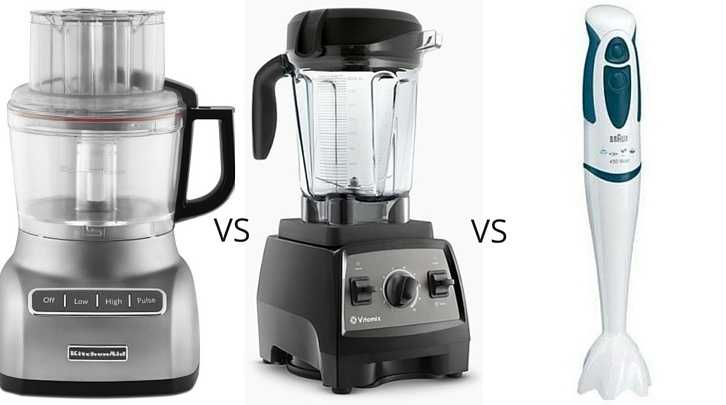A food processor, blender, and immersion blender each serve unique roles in your kitchen, but choosing the right one depends on what you need. If you’re looking to chop, slice, and knead dough, a food processor is your best bet. For creating smooth purees, smoothies, or drinks, a blender excels. An immersion blender is perfect for quick blending directly in pots or bowls. In brief, a food processor handles more heavy-duty prep; a blender is ideal for liquids and smooth textures; an immersion blender offers quick, on-the-spot blending without extra dishes. Understanding their differences helps you invest in the right tool, saving time and effort in your cooking routines.
When deciding between a food processor, blender, or immersion blender, consider what dishes you make most often. Each appliance is designed to streamline specific tasks, so knowing their strengths can make your kitchen more efficient and enjoyable. In this article, we’ll explore the key differences, uses, and benefits of each device, helping you choose the perfect gadget for your culinary needs. Whether you’re a beginner or a seasoned cook, understanding these tools will help you elevate your cooking game with ease.
Food Processor vs Blender vs Immersion Blender: Which Kitchen Tool Is Right for You?
Choosing the right kitchen appliance can make a big difference in your cooking and meal prep. Each device has its own strengths and ideal uses, so understanding their features helps you pick the best one. Let’s explore the differences between a food processor, a blender, and an immersion blender to help you make an informed decision.
Understanding the Basic Functions
Before diving into details, it’s important to grasp what each tool primarily does. A food processor is great for chopping, slicing, grating, and kneading dough. A blender excels at mixing liquids into smooth textures like smoothies or soups. An immersion blender, also called a hand blender, is convenient for quick blending directly in bowls or pots.
Design Differences and How They Affect Usage
Food Processor
- Large, boxy design with multiple attachments
- Uses a wide, flat blade for chopping and slicing
- Typically has various discs for shredding and julienning
Blender
- Features a tall, narrow jar with a motorized base
- Uses blades at the bottom to blend ingredients smoothly
- Usually better suited for liquids and soft foods
Immersion Blender
- Compact, handheld device with a blade at the end
- Hold it directly in a pot or bowl to blend
- Easy to clean and store due to its size
Performance in Food Preparation Tasks
Chopping and Slicing
Food processors are best for chopping vegetables, nuts, or cheese quickly and evenly. They can handle larger quantities with ease. Blenders are not designed for chopping; they mainly create smooth textures. Immersion blenders are limited to small-scale chopping and are not suitable for large quantities.
Pureeing and Blending Liquids
Blenders shine in making smoothies, milkshakes, or pureed soups. They produce very smooth results, especially with liquids. Immersion blenders also work well for purees, especially when you want to blend directly in the cooking pot. Food processors are less efficient for liquids unless they have a specialized wet/dry attachment.
Grinding and Dough Making
While food processors can knead dough and grind nuts or spices, blenders generally cannot. However, some high-performance blenders can handle tough ingredients. Immersion blenders are not suitable for grinding or kneading tasks.
Ease of Use and Convenience
Setup and Cleaning
Immersion blenders are quick to assemble and clean. Simply rinse the blade or wash the detachable parts. Food processors take more time to assemble and require thorough cleaning of multiple attachments. Blenders are easy to rinse but may need special brushes for the blades.
Storage and Space
Immersion blenders are compact, taking up minimal space in cabinets. Food processors are bulkier and need dedicated storage. Blenders have small footprints and can often be stored easily in kitchen drawers or on shelves.
Special Features and Accessories
Food Processors
- Multiple blades and discs for slicing, shredding, chopping
- Attachments for kneading and julienning
- Variable speed settings for precision
Blenders
- Multiple speed options and pulsation modes
- Different jar sizes for various portions
- Optional features like heating elements or ice crush capabilities
Immersion Blenders
- Adjustable speed controls
- Detachable, dishwasher-safe shaft and blades
- Additional accessories like whisk attachments or choppers
Cost Considerations
Generally, food processors tend to be more expensive than blenders and immersion blenders due to their multifunctionality. A quality blender with high power may cost a similar amount as a mid-range food processor. Immersion blenders are usually the most budget-friendly, offering good performance at a lower price point.
Choosing the Best Tool for Your Kitchen
For Quick, Easy Blending
If you often make smoothies or soups, a blender is your go-to. Its ability to produce smooth, consistent textures makes it indispensable for liquid-based recipes.
For Food Prep and Versatility
A food processor is ideal if you frequently chop, shred, or knead dough. Its range of attachments makes it a versatile addition to your kitchen.
For Convenience and Small Tasks
An immersion blender is perfect for small batches, quick purees, or blending directly in your cooking pot. It’s especially useful for busy households or small kitchens.
Additional Considerations
Power and Efficiency
High wattage models provide better performance in tough ingredients. Consider at least 600 watts for blending and 700 watts or more for food processing tasks.
Durability and Build Quality
Sturdy materials like stainless steel blades and heavy-duty plastic parts increase longevity. Read reviews to find models that withstand daily use without issues.
Warranty and Customer Support
Good warranty coverage and responsive customer service can save you money and frustration if appliances break or malfunction.
Summary of Key Differences in a Table
| Feature | Food Processor | Blender | Immersion Blender |
|---|---|---|---|
| Main Use | Chopping, slicing, kneading | Making smoothies, purees, liquids | Blending directly in bowls or pots |
| Ease of Cleaning | Moderate to Difficult | Easy | Very Easy |
| Size and Storage | Large | Small | Very Small |
| Best for | Meal prep, chopping, kneading | Smooth drinks, soups | Quick blending, small batches |
| Cost | Moderate to High | Moderate | Low to Moderate |
Understanding these differences will help you select the right device based on your cooking style, kitchen space, and budget. Whether you need a powerful machine for complex tasks or a simple tool for quick blending, knowing their unique features makes your decision easier.
Immersion Blender vs Food Processor | Which One's Better For What?
Frequently Asked Questions
What are the main differences in the types of foods each appliance can handle?
A food processor excels at chopping, slicing, and kneading dough, making it ideal for preparing ingredients like vegetables, nuts, and dough. Blenders are best suited for liquids, smoothies, and purees, handling fruits, vegetables, and ice smoothly. Immersion blenders work well for blending soups directly in the pot, making them perfect for quick purees and emulsifying dressings. Each appliance is designed for specific textures and ingredients, which influences their effectiveness.
How does the cleanup process differ between a food processor, blender, and immersion blender?
Cleaning a food processor often involves disassembling multiple parts such as blades, bowls, and lids, which can take some time but ensures thorough cleaning. Blenders typically require cleaning of the jar and blade, usually needing only a quick rinse or a short run with soap and water. Immersion blenders are the easiest to clean; you simply rinse or wipe the stick after use, and sometimes you can even clean the blending shaft by running it briefly in warm soapy water. The ease of cleanup can influence your choice based on your kitchen routine.
Can I use a blender or immersion blender for making dough?
Blenders and immersion blenders are generally not suitable for kneading dough because they lack the powerful motor and sturdy blades needed to handle dense, heavy mixtures. Food processors, on the other hand, often come with dough blades or paddles designed for this purpose. If you frequently make bread or pizza dough, a food processor offers the necessary power and versatility. Using a blender or immersion blender for dough can strain the motor and lead to uneven mixing or damage.
Which appliance offers more control over texture and consistency?
Food processors usually provide more control over different textures because you can adjust processing time and use various blades. Blenders often produce smoother textures but offer less control over coarser results unless equipped with additional settings. Immersion blenders give quick control for blending to a desired consistency directly in the container, but they don’t allow for precise texture adjustments. Your choice depends on how much control you need for your recipes.
Are there safety considerations when using each appliance?
Yes, safety varies among these devices. Food processors have sharp blades that require careful handling during assembly and cleaning. Blenders have blades that can cause cuts if mishandled and should be operated with the lid firmly in place. Immersion blenders can splash hot liquids, so you should be cautious when blending hot foods and avoid immersion too deep. Following manufacturer instructions and handling each appliance with care helps prevent accidents.
Final Thoughts
In summary, choosing between a food processor vs blender vs immersion blender depends on your cooking needs. Food processors excel at chopping and slicing large quantities, while blenders create smooth liquids and purees. Immersion blenders offer quick, versatile blending directly in pots or bowls. Consider your primary tasks to find the best fit for your kitchen.
As an Amazon Associate, We earn from qualifying purchases. When you purchase a product through Amazon links on kitchenadvising.com, we may earn a small commission at no extra cost to you. This helps support the site and keep our content free.


